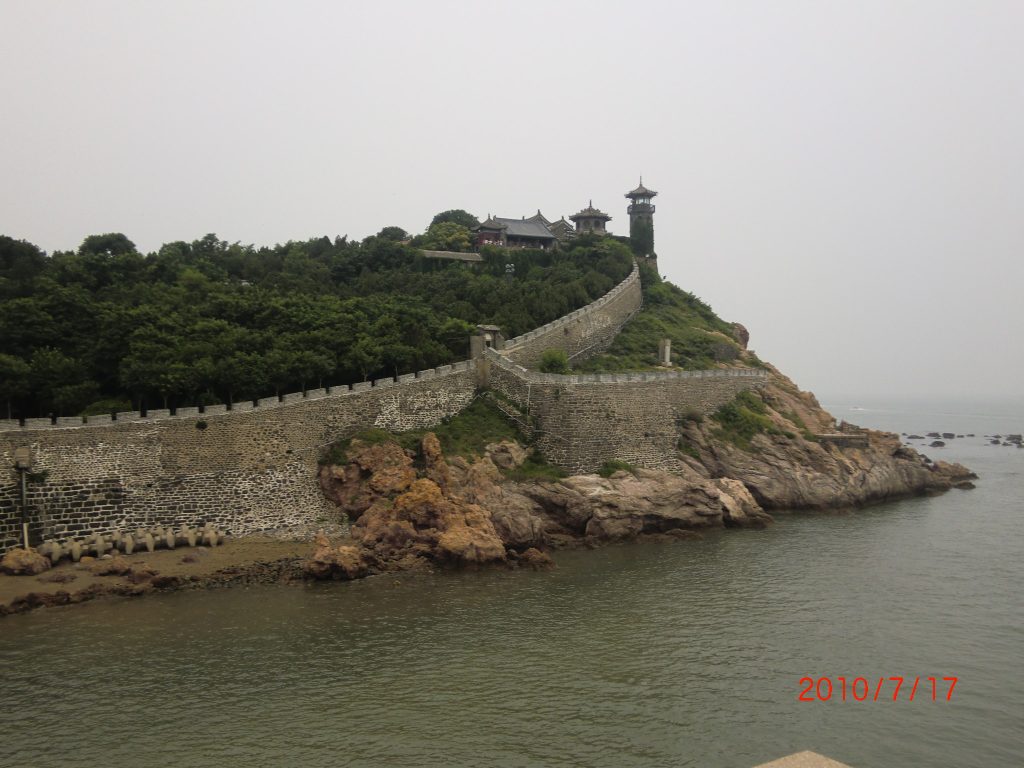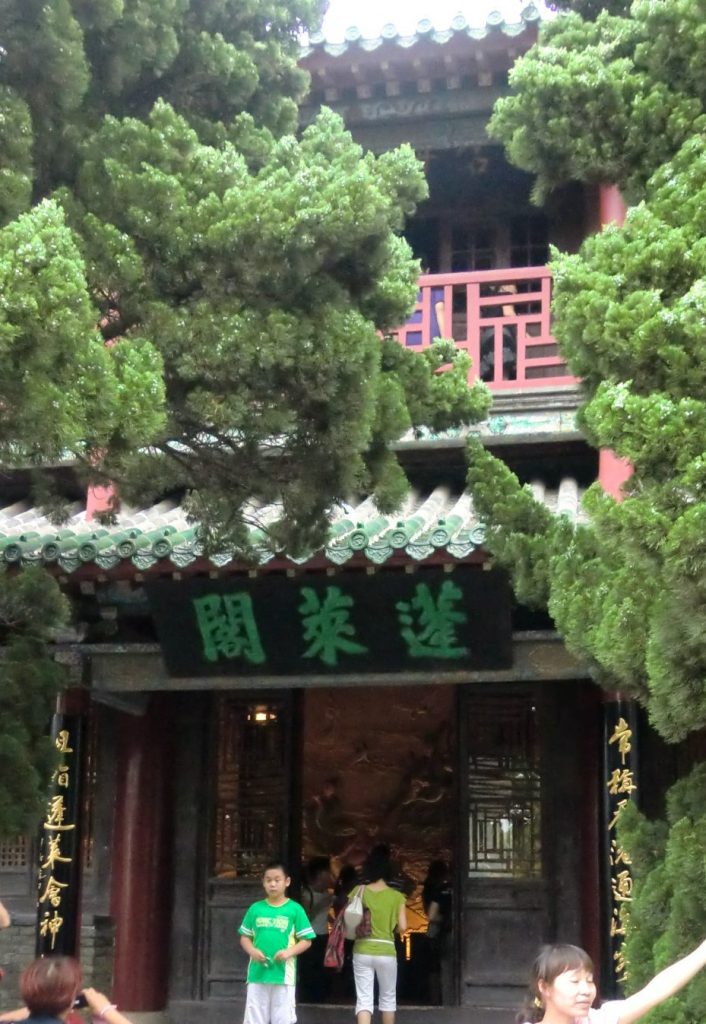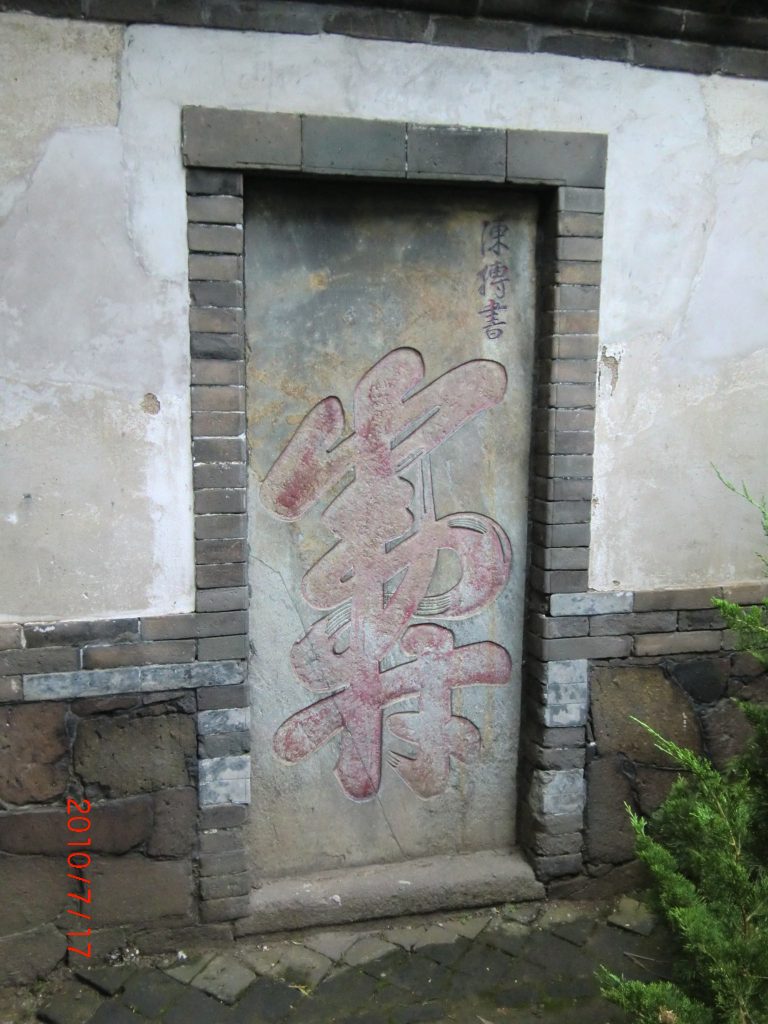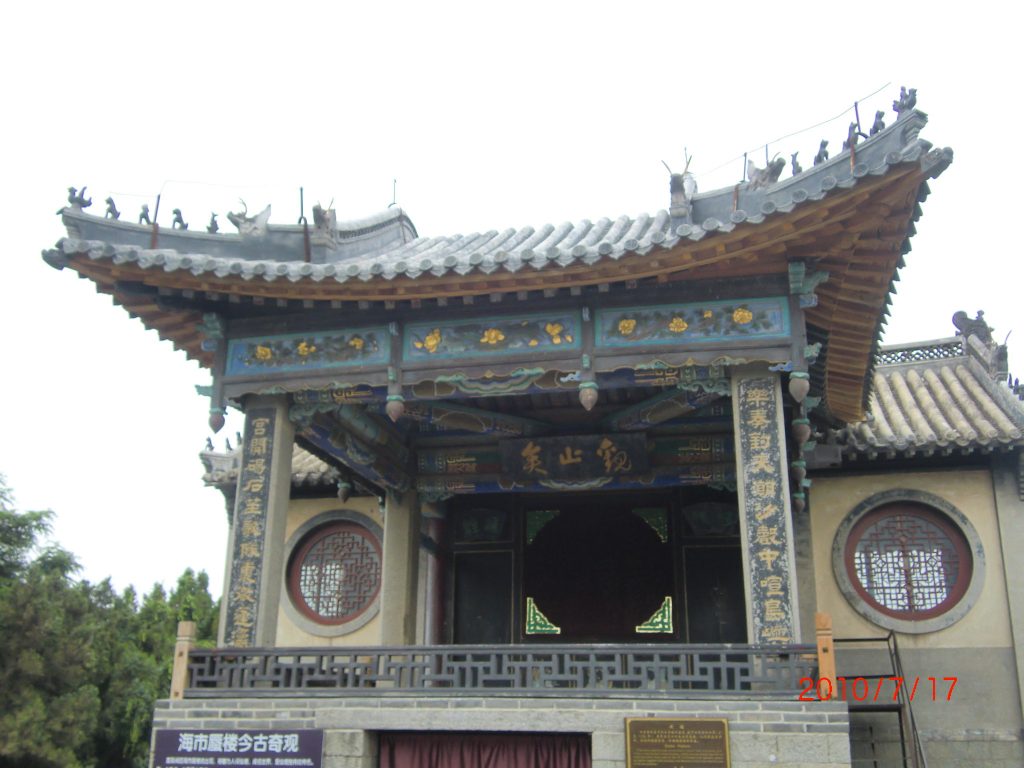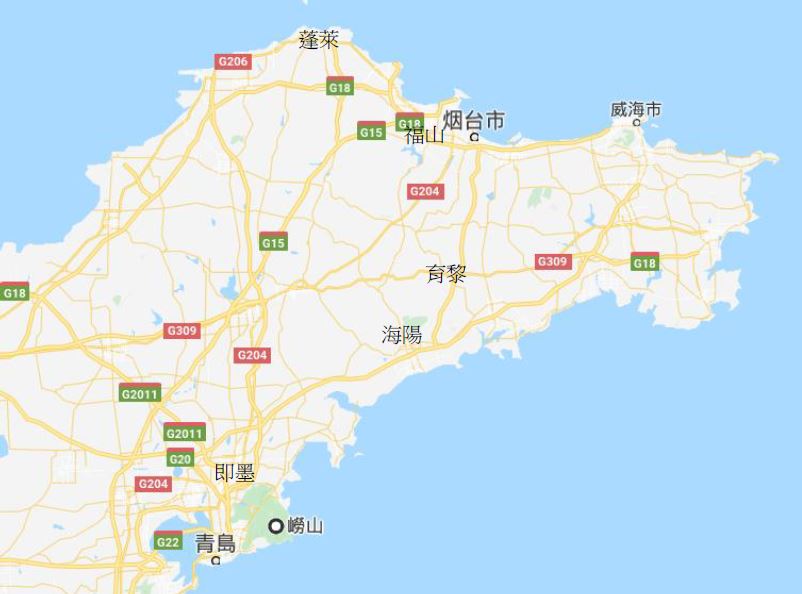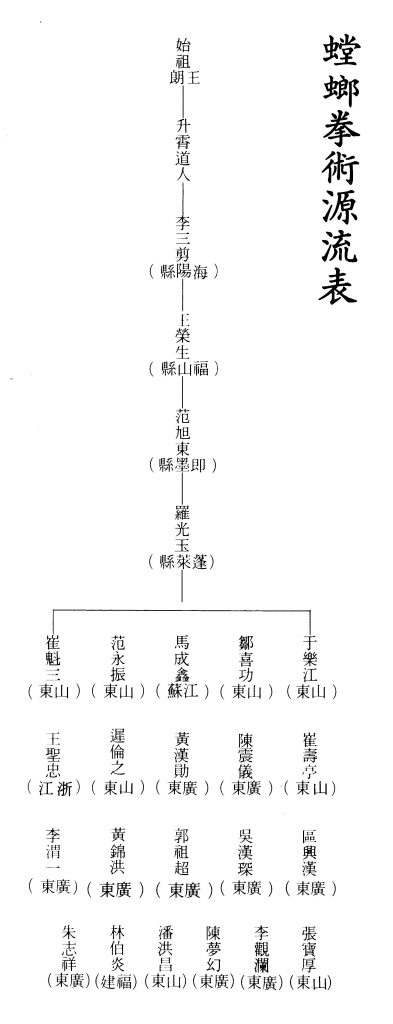
螳螂拳術起源與系統
黃漢勛
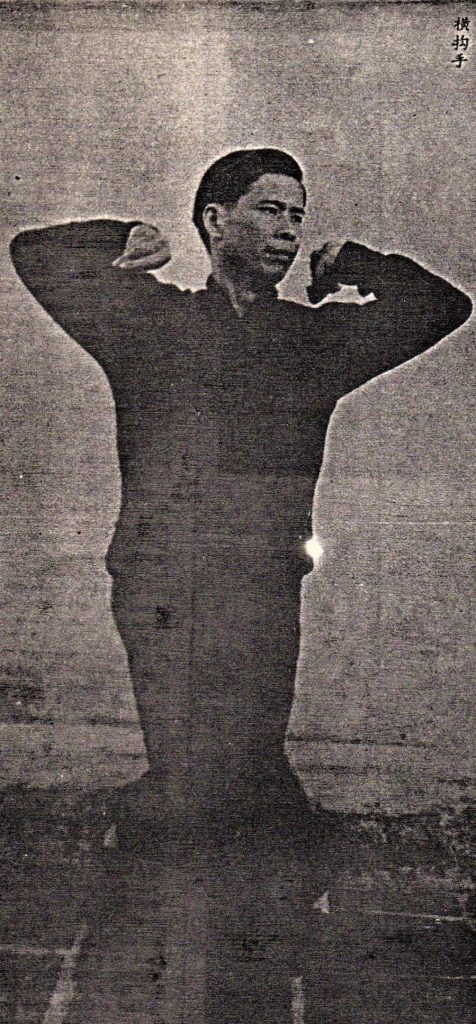
朱明末葉,有山東人曰王朗者,目覩輿圖行將變色,時思獻身家國,爭奈無路請纓,因走嵩山,投少林,習拳棒術,以圖後效。
及清兵寇關,王卽隻身赴難,又迫於內奸賣國,致英雄無用武地。鼎革後,重返少林,組織僧侶,以為復國雪恥之圖,但所如輙左,尋且為清廷偵悉內幕,下令圍焚。王與同門,展其超凡神技,保護師尊脫難。為避清兵緝捕起見,及間關遍歷數省,以迄魯之勞山,逐卓錫於此。
未幾師尊羽化,舉大師兄某為主持。日常與王拳棒相戲,以破岑寂,然王每為所敗,王恥之。誓三年後必勝師兄。
越三年,復與師兄角,又敗。王羞慚尤甚,幾欲自殺。後師兄雲遊,臨別致囑王曰:汝好好練習,吾三年便返,那時當刮目看矣。
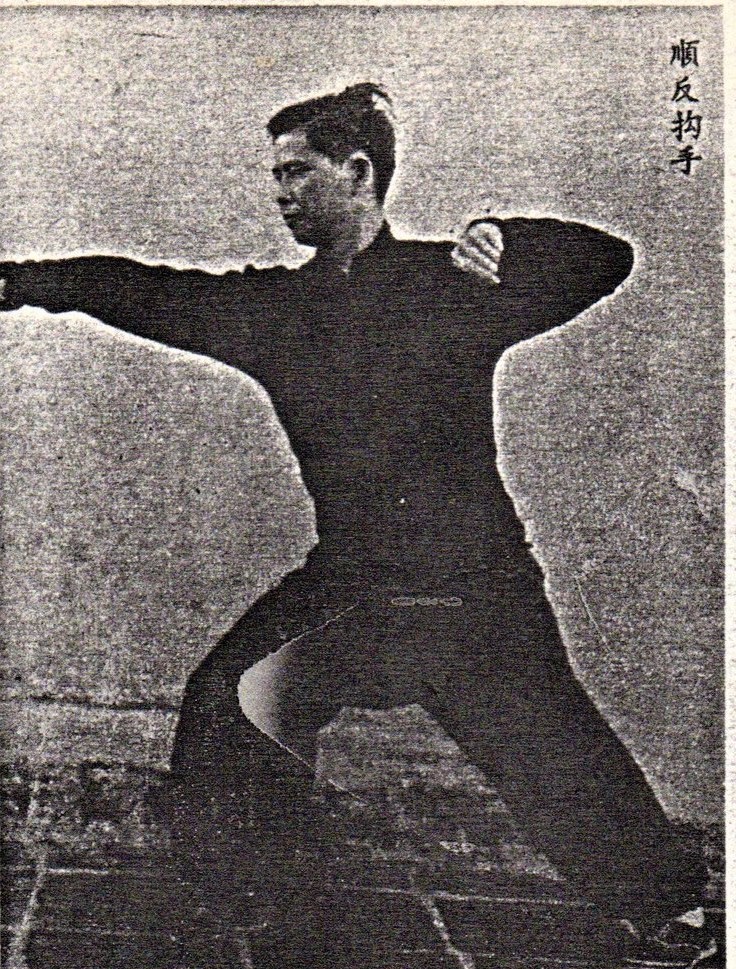
師兄去後,一日時方盛暑,悶居陋室,百無聊賴,王乃挾劍持經,入深林避暑。抵一林,祗見清風習習,身心俱快。正展經朗誦,忽聞虫聲唧唧,吱吱亂鳴,狀頗悲哀。仰首觀之,見一螳螂方與一蟬作殊死鬥。螳螂恃其鋒利雙臂,步步緊迫。未幾蟬逐喪生於螳螂之手。
王觀畢,以螳螂進退有度,長短並施,擒縱得法,大肖拳技功夫。因扳枝捕之返寺,朝夕以草桿戲之,卽粘,黏,崩,軋,閃,賺,騰,挪,兼而有之。王天資聰慧,不三日,頓悟螳螂之手法共分十二種,卽勾、摟、採、掛、刁-進、刁-打、粘、黏、貼、靠。而貫入十七家宗法之精華,並採猴猿步法渾為一體三載後自成一家。
適師兄倦遊歸來,因與王角,師兄未及審視,已被跌尋丈外。驚問其故,王舉以告之,是卽螳螂鳴名之時也。自此益知拳技之道實止境,因與師兄勤加研練,便螳螂之藝益臻妙境。
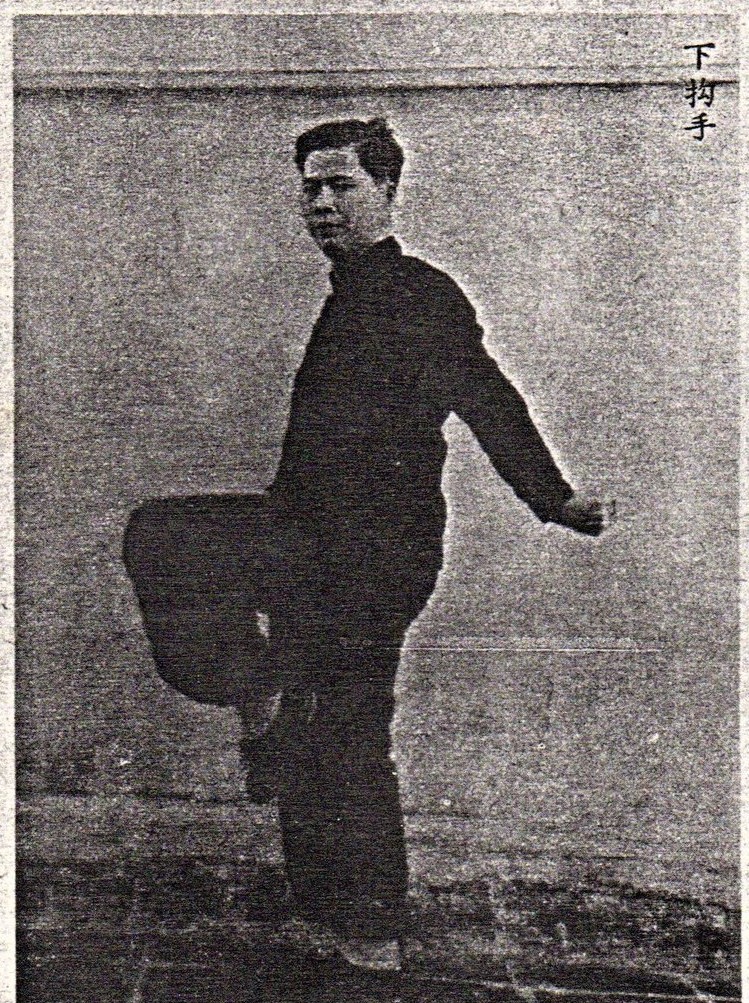
不十年師兄與王先後辭世,該寺僧侶視螳螂拳不啻至寶,不輕示人。後有升霄道人遊雲至此,得承衣砵,螳螂掌始流傳於外。
道人再傳海陽縣李三展。李技成,設鑣局於濟南,盛名遠播,大江南北綠林豪傑,聞「閃電手」之名,莫不致服,畢生英名不替。
至晚年,因無嗣,遍覓賢者以承其技。至福山縣,聞王榮生者,乃新科武進士,登門訪之,求演技。以王成名之大刀術獻。李觀畢,不贊一語,曰:技止此而巳乎?何名之不符若此!王怒極,掹扑之,巳失所在。正徬徨間,笑聲起於背後,因轉身取之,未得,反為所制。因求師事之,數年盡其技,李亦失踪,不之何去。王家富厚,旣不求士進,亦不以技炫人,閒則用作消遣,寒暑無間,數十年如一日,技益猛進。王晚年傳烟台范旭東。
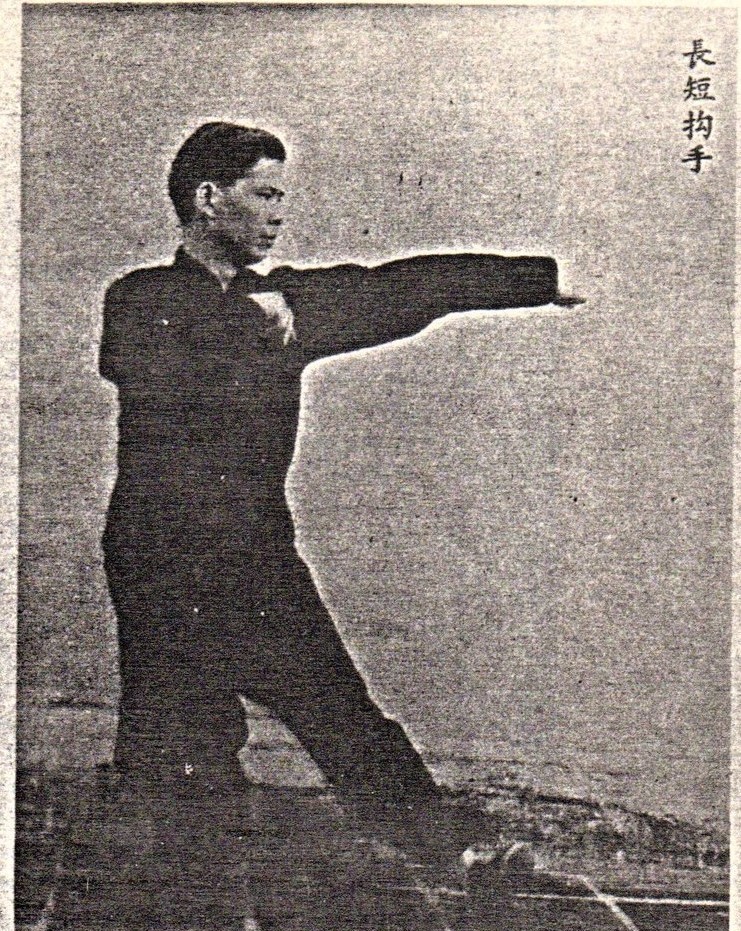
范體格魁梧,重逾三百磅,有巨人之稱,精鐵砂掌范氏再傳羅光玉等人。民國八年【1919】,上海精武體育總會,仰慕螂螳拳技,乃派員北上,延聘羅師光玉南下申江【即上海黃浦江】任總教練之職。
至民國十八【1929】年舉行全國運動會於首都,其弟子馬城鑫,代表上海市出席參加動手比賽,結果名列前茅,京滬各報競為刋載,羅師之名益噪。
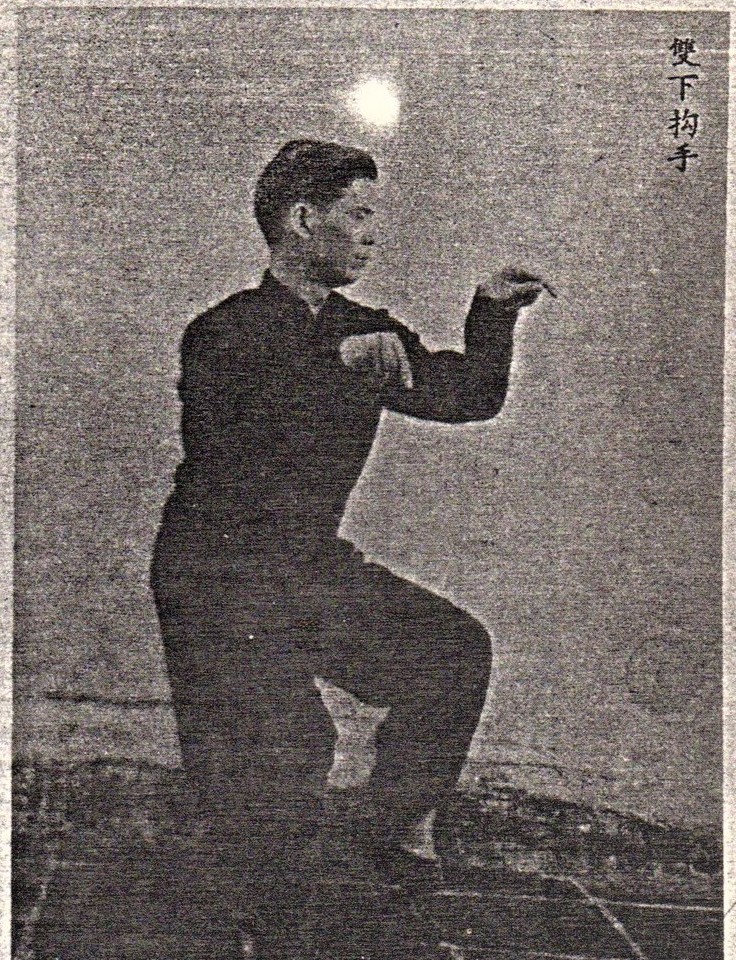
一二八淞滬戰起,上海精武被毀,會務廢弛,香港精武主事人以羅師乃螳螂正宗,得此機會焉能放過,乃電上海臨時辦事處,促駕南來。自此港中人士,始知螳螂拳技之真相,其留下港中之印象極佳。後香港淪陷,羅師乃買舟北返,不幸為病魔纏於春申【即上海】。此一代宗師,撒手人寰,長眠地下。
螳螂拳流傳至編者一輩,便是第七傳歷三百年。
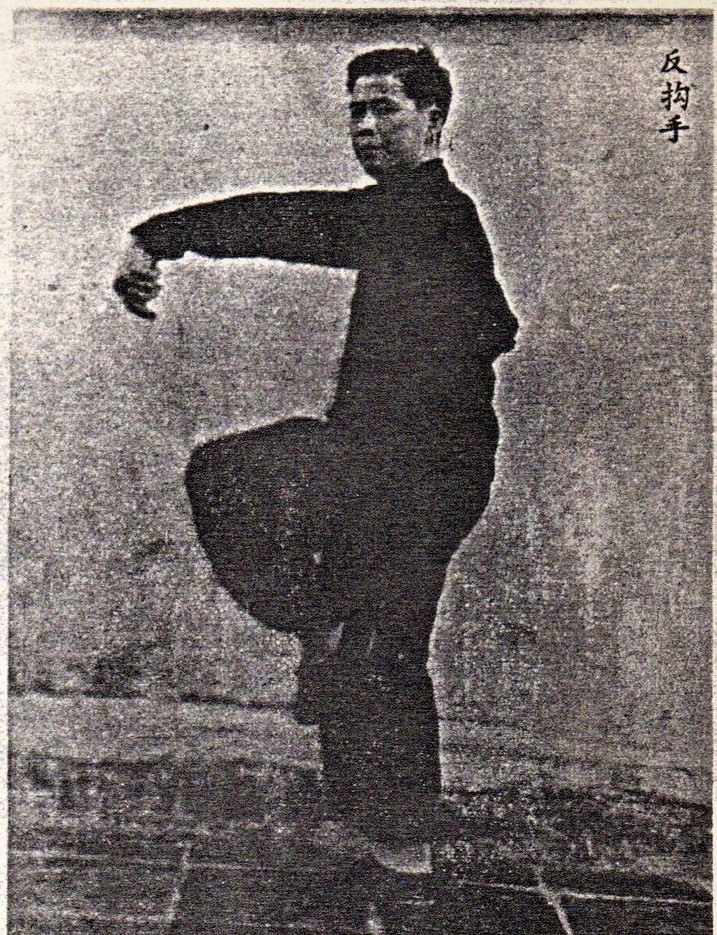
The Origin and Development of the Northern Style Praying Mantis school of Chinese martial art
by Hon-Fan WONG,
translated into English by Pang-Ying Wong
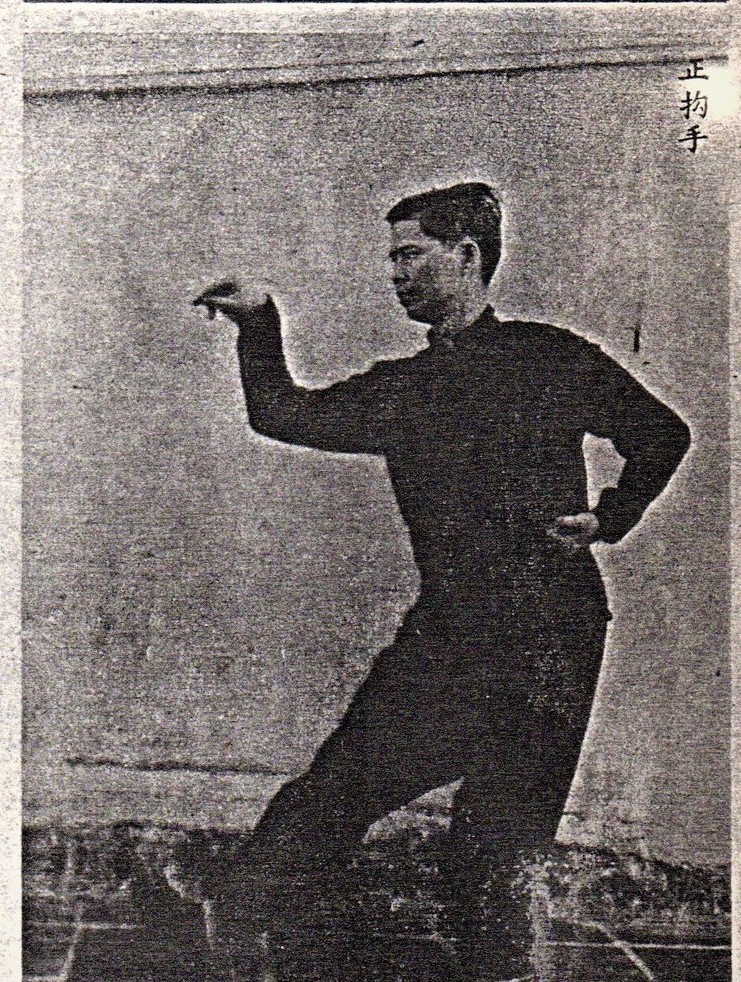
Origin
At the end of the Ming Dynasty (1368-1644), there was a native of Shandong by the name of WANG Lang. He was a very patriotic man; and, seeing that the Ming government was about to be overthrown, he was always thinking of offering his body and soul to save the country. However, his attempts were futile and his enthusiasm rejected. Hence he ran away to Song Shan, and practised martial art in the Shaolin Temple, hoping that one day this would be of help to the country.
When the Qing army took over the reign of China (1644), Wang thought that this was his time. However, he again found no place in the Ming-resistant army for him. So he returned to the Shaolin temple, and planned to fight with guerrilla forces against the Qing government. Unfortunately, their plans were discovered by the later, which ordered the temple be burnt. By the help of his colleagues, Wang accompanied his sifu to safety. To avoid being caught back by the soldiers, they took route to the highland and eventually arrived at Lao Shan in the Shandong province.
Before long, Wang’s sifu passed away of old age; and one of Wang’s senior succeeded in his place. To spend away the time, every day Wang combated playfully with his senior, both naked-handedly and with weapons. However, there were few times when Wang was not defeated. Wang was almost ashamed; he promised himself that he must excel his senior after three years.
Three years passed easily. Well prepared, Wang combated again with his senior. He lost again. Now Wang was so ashamed that he almost thought of killing himself! Then, one day Wang’s senior told him that he was leaving to tour around for a while, and would not be back until after three years. He also bid Wang to practice martial art continually, and he expected great advances in wang’s skills when he returns.
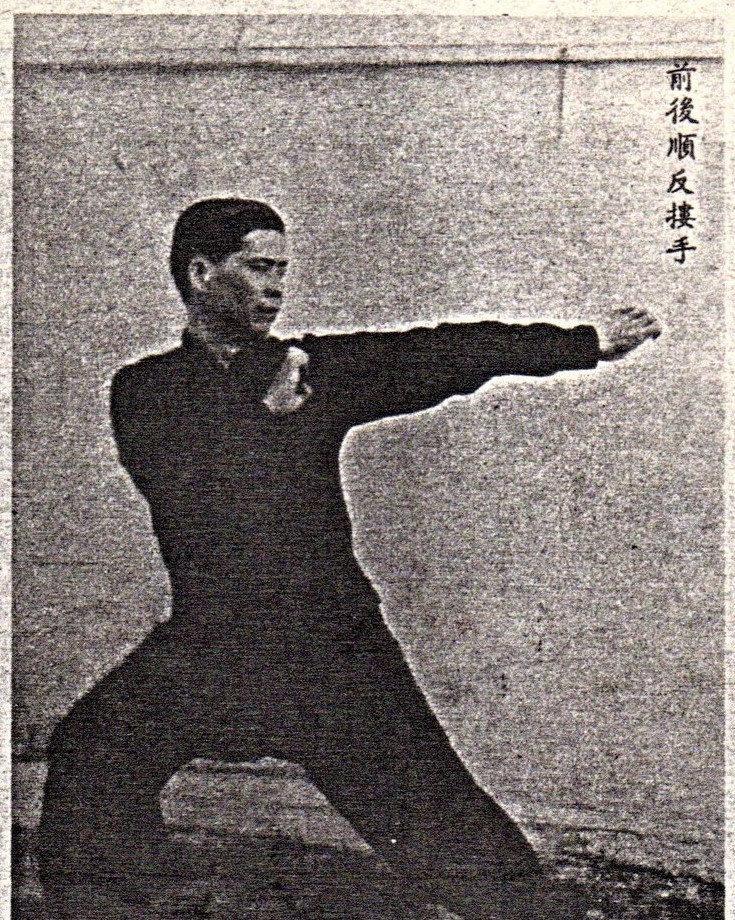
One hot day during his senior’s leave, Wang found it boring to stay in his chamber. So he took his sword and some books and sought resort in the woods. Just as he has cooled himself down and was beginning to turn the pages of a book, he heard some hissing sound. The sounds even seemed desperate. Wang looked up and found, high in a tree, a praying mantis and a grasshopper fighting to the death. By means of its strong arms and chisel-like claws, the former attacked the latter ruthlessly. Very soon, the grasshopper fell dead.
An idea came into Wang’s mind. The praying mantis played artfully during its kill. He attacked and retreated at the right moments; using long distance blows and close crushes correctly; and grasped and released methodically. Does this not resemble the skills one use in martial art? So, he climbed up the tree and took the praying mantis back to the temple; and henceforth provoked him every day with a piece of straw, watching carefully the reactions of the praying mantis.
Being an intelligent man, Wang discovered very soon that the praying mantis made use of twelve principal methods for attack and defense, namely, gōu, lǒu, cǎi, guà, diāo-jìn, diāo-dǎ, zhān, nián, tiē, kào. He took into reference the steps of the monkey. He further took the best points out of seventeen other schools of Chinese martial art at that time, and merged them into one unique, concise school, now known as the Northern Style Praying Mantis school.
When Wang’s senior returned after the three years, he combated again with Wang. Not knowing Wang’s great improvement in his skill, he was thrown yards away during the combat. Shocked, he asked Wang for the story behind. Wang told him all that happened. After that, they practiced with each other on the newly invented skill, refining the art to superior level.
This is how the Northern Style Mantis School of Chinese boxing was invented.
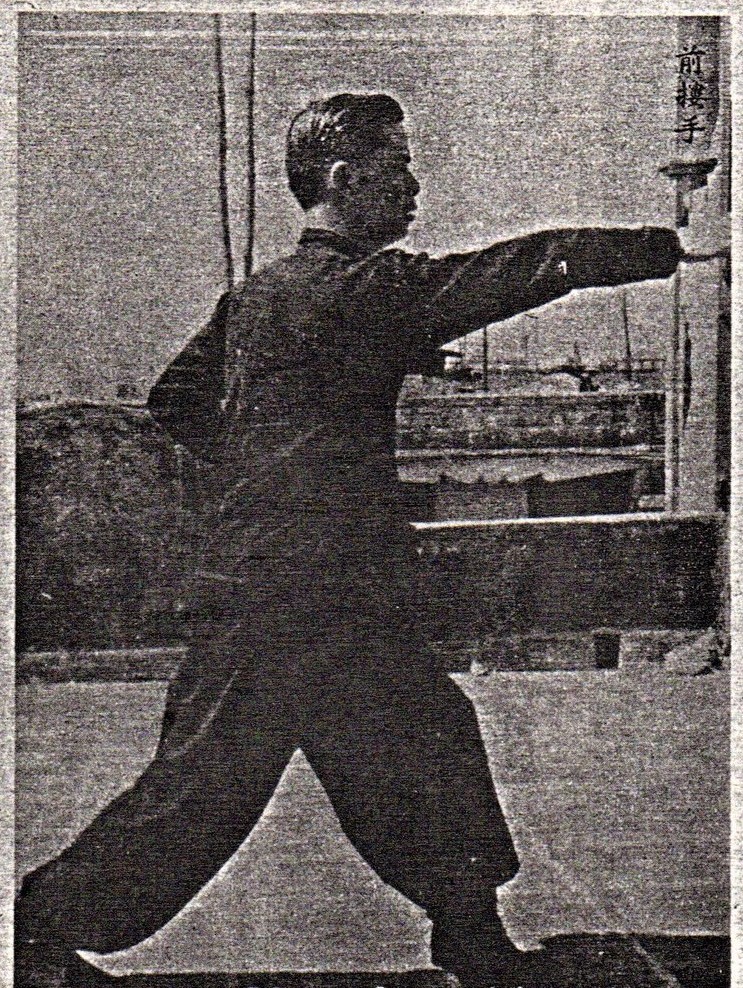
Development
A few decades later, both Wang and his senior passed away. But at the art of the Praying Mantis school was not lost. Rather, it was transmitted among the monks in the temple. However, the lineage was confined to the temple until a Daoist monk by the name of Sheng Xiao Dao Ren passed by during his hike over the country. He was taught the art and from then on, the Northern Mantis school was able to circulate around China.
Dao Ren taught the art to LI San Zhan of Hai Yang. When Li had acquired all that his teacher knew, he established an escort service firm in Jinan, delivering valuable goods of clients to target various destinations. The firm earned great fame in Northern China for its reliability and safety service and he himself was named by robbers as ‘Li the lightning fist’. No one was ever able to defeat him.
But when Li got older, he was worried that there would be no one to learn the art that has brought him fame and prosperity, for he has no sons. So he went everywhere searching for someone who had a good enough basic training in martial art to succeed the Playing Mantis art. He was not disappointed. When he came to Fu Shan, he heard of a man called WANG Rong Sheng, who was the national martial art champion that year. So Li visited Wang and asked the latter to perform his winning technique, broadsword. After watching that latter play, Li jeered at him, saying that it was not worth the championship. Wang was extremely angry and tried to beat up Li. But before he could reach the latter, he seemed to find the latter disappear out of the air, and at once laughter rose at the back. So he turned to grab Li, but was in vain. On the contrary, he was held unmovable. Knowing that his skill was no match for the elder man, he asked Li to be his teacher. In the few years that followed Li taught him without reserve all that Li knew.
Wang’s family was a wealthy one. So he did not have to worry about getting money, not did he want to show off the art he had learnt to outsiders. He just practiced it as recreation. During his last years, he taught the art to FAN Xu Dong of Yen Tai.
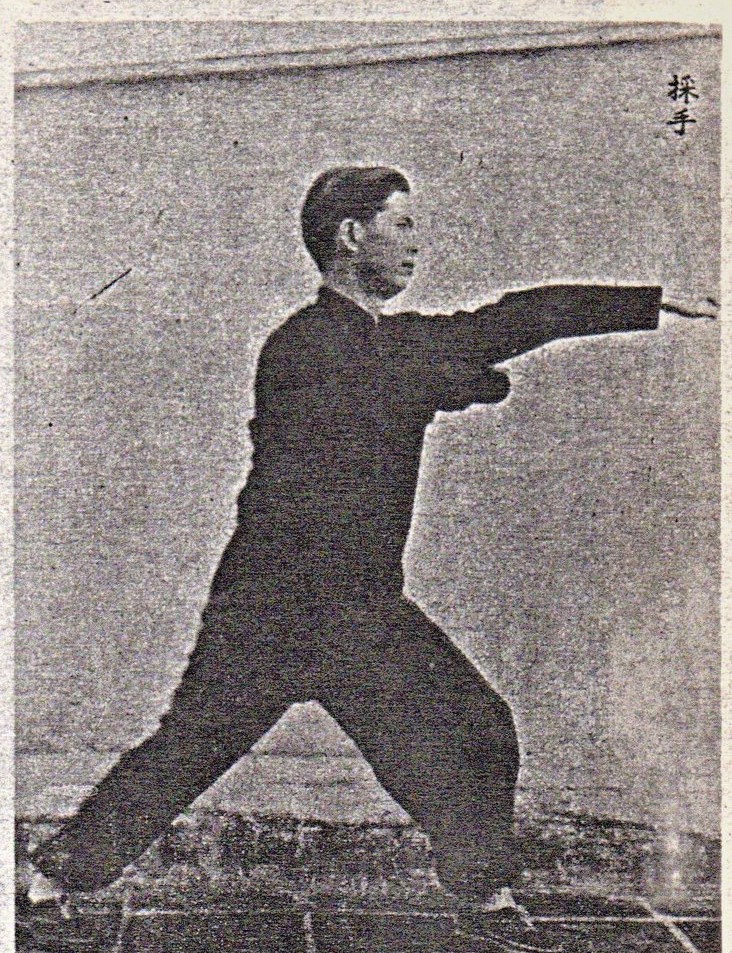
Fan was a huge man, weighing over three hundred pounds; and was known to people as ‘giant fan’. He was particularly expertise in the skill of ‘iron granules palm’ (a feat practiced by poking the palms into a tank of iron granules).
Fan later taught the art to a number of students, grand-master LUO Kwong Yu was among one of them. In 1919, the council of the Shanghai Chin Woo Athletic Association was astounded by the perfection of this school, and so sent a representative in person to Shandong to invite Grand Master Luo to become senior instructor, and escorted grand-master Luo to Shanghai.
In 1929, a national contest of Chinese martial art was held in Nanjing and one of Luo’s student, MA Cheng Xin took part, representing Shanghai. Ma won the first prize. His name, as well as that of his sifu, Grand Master Luo, thus appeared in all the newspapers of Shanghai.
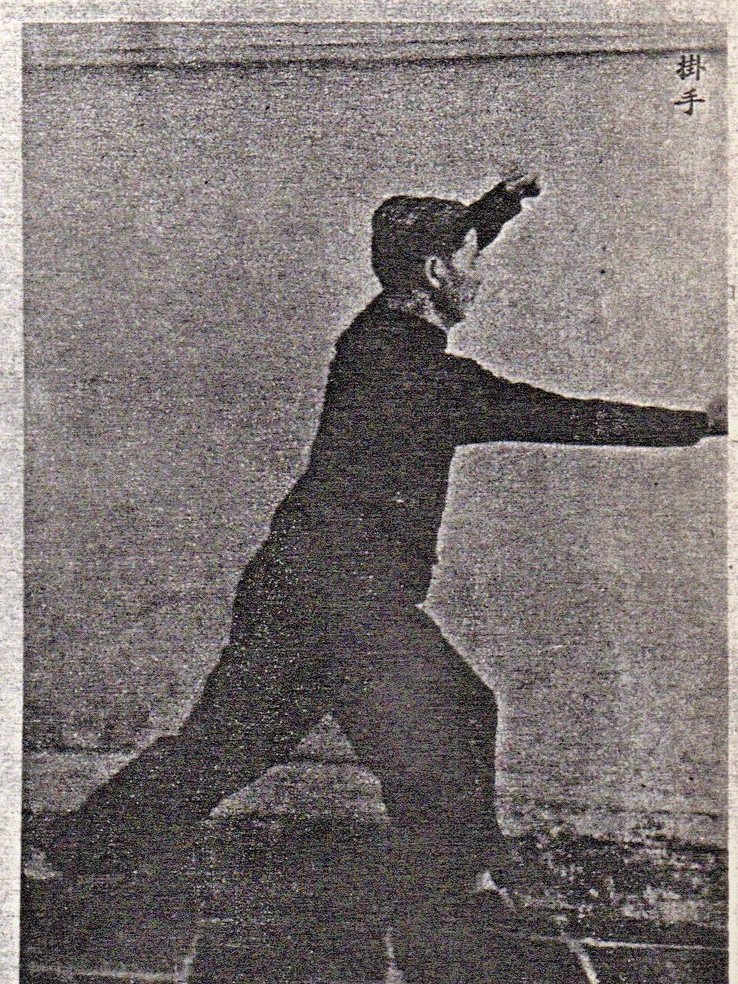
In 1932, Luo was sent by the Central Chin Woo (Shanghai) to teach at the Hong Kong branch. He did so until 1944. It was this opportunity that Master Wong had a chance to learn all the art from Grand Master Luo (a brief biography of Master Wong is found in the passage beneath).
From the invention of the Northern Praying Mantis school of Chinese Martial Art until today, there was a history of three and a half centuries (that refers to the 1970s). With continual refinement and improvement in the art, it has now become one of the most perfect schools in Chinese martial art currently being practiced.

